Matador Network's Blog, page 407
October 4, 2022
This Lululemon Duffle Is the Only Weekend Bag You’ll Ever Need

Ever since my now one year old daughter was born, I have found myself taking many more short trips. I haven’t lost the desire to travel, I just don’t want to be away from home for as long as I used to. As a result, the trusty large suitcase which has seen the baggage terminal in Rome, New Orleans, and London has been retired to the attic closet. So when I decided I needed a smaller bag, I looked for something stylish but compact, that can still fit at least a few pairs of shoes and a change of clothes. The Lululemon City Adventurer large duffle bag meets all these requirements, and it hasn’t let me down yet.
The sleek black material is water resistant, so the bag is durable and appropriate for any season or weather. Its versatility is at the heart of its appeal. I’ve thrown bathing suits, light dresses, and sandals in it for a beach trip on the Jersey Shore and packed it with sweatshirts and thick socks for a two-night stay in a cabin in the Adirondacks. Beach vacation, camping, bachelorette party — you name it, this Lululemon duffle bag can accommodate enough.

In the Newark airport bathroom on the way home from Mexico. Photo: Elisabeth Sherman
Even though the bag looks compact, it’s surprisingly spacious. On a recent trip to Seattle, I used it not as my luggage, but for my daughter. I fit three , pajamas and day time outfits for four nights, a handful of small toys, two books, and a pair of her shoes inside. Sometimes it feels like Mary Poppins’ bottomless purse.
It comes with a detachable strap so you can sling it across your body or carry it by the handles. One benefit of the bag is that no matter how you choose to carry it, it’s not bulky, so it’s easy to trek through the airport without feeling weighed down. It’s also easy to stow in an overhead compartment alongside traditional suitcases.
In general, it doesn’t take up a ton of space, which is what I love about it: Because we have to fit a stroller and suitcase in the trunk (as well as whatever my partner packs), I can easily toss this duffel bag in the back seat, with room to spare.
There’s an expandable compartment on the bottom of the bag which Lululemon specifies is for storing sweat-drenched clothes post-gym, but that’s usually where I pack dirty clothes at the end of a trip, a still-damp bathing suit, or an extra pair of shoes if I plan to dress up one night. So far, I’ve managed to fit one pair of sneakers, a pair of Tevas, and strappy sandals for going at night into this bag with little effort.
In terms of toiletries, I can usually fit a gallon-size Ziplock bag with a facial cleanser, moisturizer, and a few other items from my skincare routine inside — but usually not a full-size lotion, shampoo, and conditioner. If you’re taking a short trip but if you still prefer to pack all your own hygiene products, you might consider a slightly bigger bag.
Cold weather clothing usually isn’t a problem either. For weekend trips, I need just one jacket, and that’s usually my lime green Patagonia Nano Puff Jacket because it’s easy to fold and flatten. Add a comfy, soft sweatshirt on top of that,. If you’d rather bring a longer, heavier, raincoat or insulated winter coat, you might need to wear it on the plane, or else you’ll have to toss it in your trunk.
The Lululemon City Adventurer is well named. So far, it’s accompanied me to Seattle, Lake George in upstate New York, Asbury Park and Wildwood on the Jersey Shore, Cancun, Oklahoma City, and later this month, I’m taking it with me to Austin. I love that it’s compact, space-saving whether I’m traveling by car or plane, easy to carry through an airport or on the long trek to an isolated cabin, and that I can use it for any vacation, for either me or my daughter. This Lululemon duffle bag works any time, anywhere — and for a person who travels frequently, that’s the kind of flexible luggage I need. 
Nevada hot springs, mapped
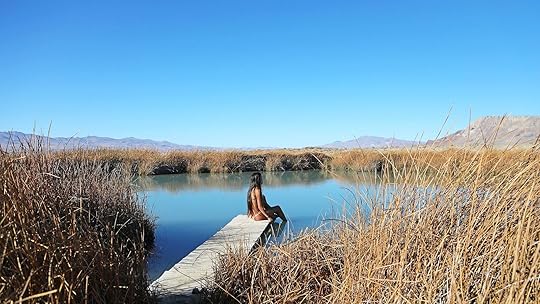
With more hot springs than any other US state, Nevada presents something of a challenge in choosing where to soak. Add to that the fact that much of Nevada is extremely remote (and Google Maps can be less than helpful), and it can become a real adventure to try to find where you’re supposed to go.
Fortunately, some of the best hot springs in Nevada are well-mapped — and gorgeous, with views looking across remote valleys and onto massive mountain ranges.
These are the 13 best hot springs in Nevada, plus how to find them and how to enjoy the unique natural experience.
Important: Explore responsibly and read up on hot springs etiquette before beginning any trip. And be prepared: reaching many of these Nevada hot springs requires hiking and/or long drives in remote areas without cell phone service, so download a map in advance. Remember that Nevada is mostly desert, which means days can be well over 100 degrees Fahrenheit in the summer, but still very cold (below freezing) at night in the winter. Do your research, pack accordingly, and start at the developed springs near cities like Reno and Las Vegas if you’re not comfortable being the only car on the road.
Map of Nevada Hot SpringsThis is hardly a complete map, considering the number springs in Nevada. But travelers looking to make a quick choice about what springs to visit should consult the map below as some of the hot springs require long, remote drives to reach (and Nevada doesn’t have that many developed cities to begin with).
Gold Strike Hot Springs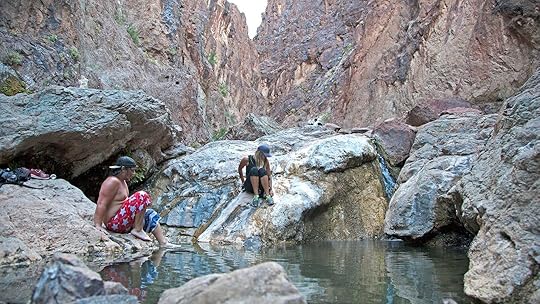
Photo: Travel Nevada/Sydney Martinez
Those who reach Gold Strike Hot Springs really have to work for it — it’s not the easiest to reach. It’s on the Colorado River and technically only 45 minutes from Las Vegas, but the four-mile hike through a narrow canyon to reach the spring makes it feel much farther. The hike is doable for most hikers but slightly technical, requiring some scrambling and a few careful maneuvers. But visitors who make it will get to relax in a natural hot spring where hot water seeps from fissures in the canyon walls.
Spencer Hot Springs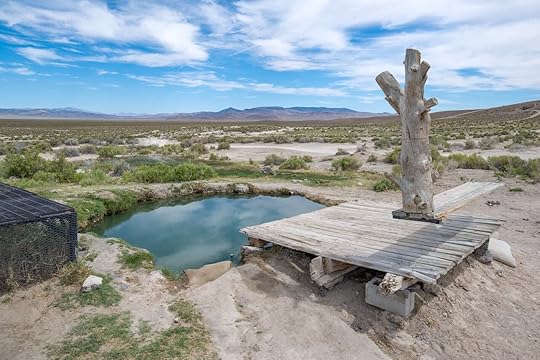
Photo: Dominic Gentilcore PhD/Shutterstock
The vast Nevada desert backed by the jagged peaks of the Toiyabe Range — that’s the view visitors have as they soak in the improved primitive pools at this Nevada hot spring. Sitting just off the “Loneliest Road in America,” Spencer is easily accessible and consists of a super steamy metal tub and an in-ground spring. After soaking, travelers can camp nearby or book a hotel room in Austin — a historical town with antique shops and a few hotels.
Fish Lake Valley Hot Springs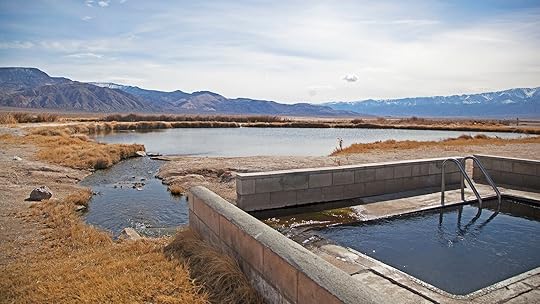
Photo: Travel
Popular among ATVers and RV campers, Fish Lake Valley is one of the few hot springs in the state with amenities such as fire pits. It can get busy, so embrace the company or try to hit it midweek when the crowds are smaller.
Surrounded by two mountain ranges in the middle of Nevada’s Great Basin, Fish Lake Valley has a large concrete hot pool with a temperature of around 105 degrees Fahrenheit, which feeds two naturally warm ponds ideal for lazing on a floating raft. While visiting, be sure to look west to see Boundary Peak. With a summit 13,146 feet above sea level, it’s the tallest mountain in the state.
Carson Hot Springs Resort
Photo:
Smack in the middle of Carson City, just to the east of Lake Tahoe, is this no-frills, family-friendly hot spring resort with a large outdoor pool, 10 private soaking rooms with adjustable temperatures, fire pits, and a powerful massage fountain known as “the hammer.”
Unlike with many Nevada hot springs, the water doesn’t smell like sulfur. While it does flow naturally from an underground spring (at 121 degrees F), it gets treated and cooled to create the variety of temperatures in the tubs and pool. The resort is open from 8 AM to 9 PM daily.
Soldier Meadows Hot Springs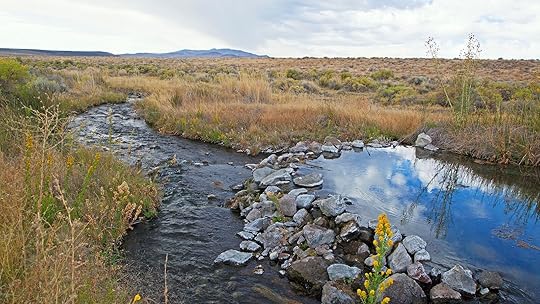
Photo: Travel Nevada/Sydney Martinez
The multiple natural pools at Soldier Meadows sit adjacent to dozens of trails and creeks, and this is a great place to spend a night or two — there’s plenty of free BLM camping in the area.
It’s sort of in the middle of nowhere, near the Black Rock Desert. But it does get busy before and after the annual Burning Man festival, so avoid the weeks around Labor Day if you want any chance for peace and quiet while you soak.
Rogers and Blue Point Springs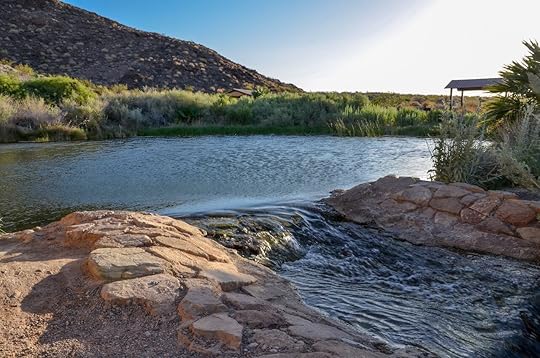
Photo: Serj Malomuzh/Shutterstock
More warm than hot, Rogers Hot Springs is located not too far from Las Vegas at Lake Mead National Recreation Area between Echo Bay and Overton. Rogers and the nearby Blue Point Spring help support a desert ecosystem that includes vibrant desert palms and other greenery. If you’re making a day trip from Vegas, drive along the shore of Lake Mead on the way out to swing through the Valley of Fire on your way back to town.
Black Rock Hot Springs
Photo: Travel Nevada/Sydney Martinez
Named after the recognizable rock in the distance that gives Black Rock Desert its name, this large, sandy-bottomed pool is awfully inviting. Just be careful getting in, and always check the temp before going fully under. A wooden plank leads into the pool and is the easiest way to get in, especially since the water at the other end of the pool can be burning hot.
When visiting any and all Nevada hot springs, it’s best to keep your dog on a leash, but it’s especially true here as pups may burn their paws if they get too close to the wrong end.
Steamboat Hot Springs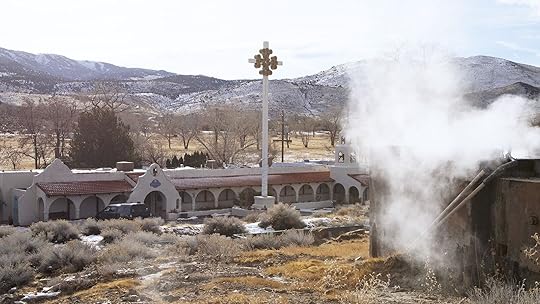
Photo: Travel Nevada/Sydney Martinez
Steamboat Hot Springs is a commercial hot springs resort with vintage vibes just south of downtown Reno. It has an outdoor tub, private baths, a steam room, plus massages and aromatherapy. Water comes from a geothermal source and contains the same healing minerals you’d find in a natural hot spring. Drop-ins are welcome for the outdoor tub, but appointments are recommended for any of the spa’s other services.
Arizona Hot Springs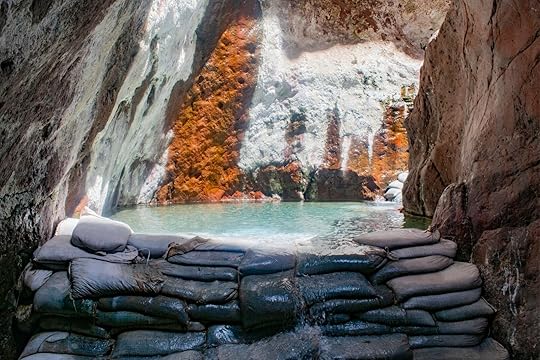
Photo: Beth Schroeder/Shutterstock
This three-tiered hot pool sits in a dark slot canyon near Hoover Dam, just across the Arizona border. Getting there requires a three-mile hike along a flat, sandy wash starting from the trailhead on US-93 South.
Arizona Hot Springs is the most accessible hot spring near Las Vegas, so the area can get busy. For the best chance at solitude, go for a late-night soak and consider camping on the beach on the edge of the Colorado River. It can be quite hot — as in, well over 110 degrees F — midday in the summer, so consider visiting sometime between late October and April for the best hiking weather.
Trego Hot Springs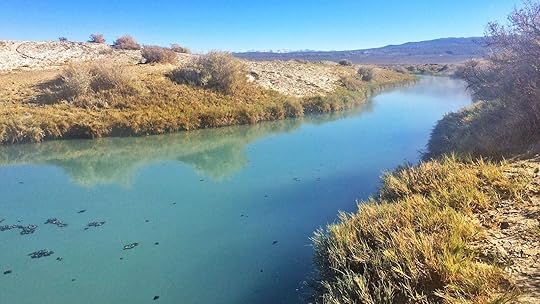
Photo: Travel Nevada/Sydney Martinez
One of the best things about Trego Hot Springs is how accessible it is. It’s less than a one-mile hike to reach the springs, and because it’s on BLM land, visitors can camp anywhere nearby they like (so long as they’re at least 300 feet from the water). Because it’s rather far from any major city (Reno is 2.5 hour south) it’s rarely ever crowded — except during Burning Man, when the vibe goes from “pastoral peace” to “party time.”
Ruby Valley Hot Springs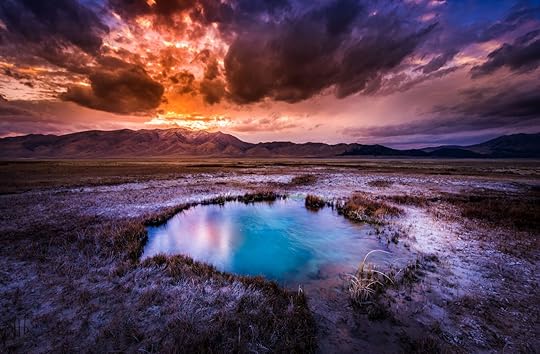
Photo: Kris Wiktor/Shutterstock
Ruby Valley Hot Springs is one of the best Nevada hot springs for travelers seeking a totally natural experience (and yes, that means nudity is common). The springs are totally natural, with no manmade walls, dams, or platforms around the various pools. They range in temperature, but are all roughly around 100 degrees, and the large main pool can accommodate dozens of visitors at once.
Ruby Valley Hot Springs is quite remote, requiring about 15 miles of driving on uneven country roads. The closest town is Elko, but it’s still about an hour away. Be sure to load up on water and food (and download your directions) before leaving Elko.
Kirch Hot Springs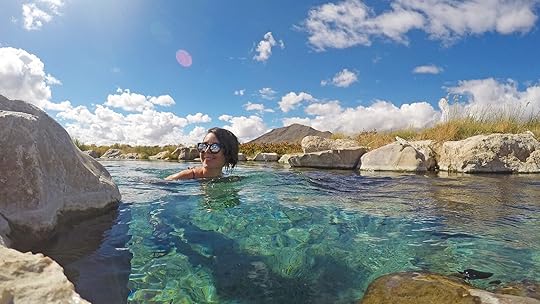
Photo: Travel Nevada/Sydney Martinez
These hot springs, known as the Kirch Hot Springs, are technically called the “Wayne E. Kirch Wildlife Management Area” hot springs. But everyone knows them as Kirch, and they’re quite popular. That’s probably because they’re downright gorgeous, with bright blue water and yellow sagebrush, plus epic views of Nevada’s high country in the distance. Travelers who sit in the springs long enough may be lucky enough to see some of the area’s protected wildlife wander by, including coyotes, bobcats, badgers, and more. Plan to camp at the management area as there isn’t much else nearby.
Kyle Hot Springs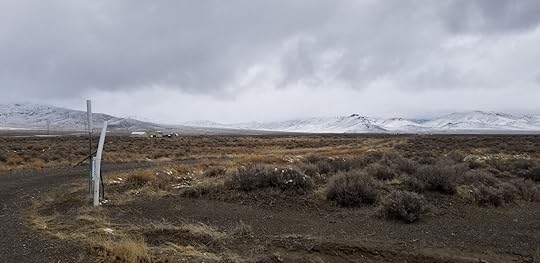
Photo: AAgoldy/Shutterstock
Last on the list but certainly one of the best Nevada hot springs is Kyle Hot Springs, in northern Nevada. It has great views out onto the desert, and though it used to be a resort, it’s now totally abandoned, save for a few old fences and gates. The water from the main pool (which is gated) is extremely hot, so visitors should use the pools further down the hill. The closest town is Winnemucca (56 miles away) and there’s no developed camping anywhere nearby either, so plan to stop when you’re driving through or car camp on BLM land nearby.
Because this used to be a resort, some of the pools are actual tubs, and visitors will need to fill the tubs from underground pipes, which means the smell of sulfur can be a bit strong. Be sure to dip a toe in the water before climbing in, and empty your tub after you leave (and better yet, wipe it down to leave it clean for the next person, too).
How many hot springs are in Nevada?Though most people may associate Nevada with Las Vegas, the state is actually quite huge — much larger than just one city. Nevada covers more than 110,500 square miles, which leaves plenty of room for hot springs. In fact, it leaves room for more than 300 natural hot springs.
That means that hot water bubbles out from the earth in 300 places, but the actual number of places where travelers can soak in that water could be much higher. Nevada has the most hot springs of any state in the US, though the surrounding states — primarily California and Oregon — are also very geothermically active.
Does Las Vegas have hot springs?
Rogers Hot Spring, near Las Vegas. Photo: Travel Nevada/Sydney Martinez
Good news for non-gamblers: there are tons of hot springs near Las Vegas that make for a perfect day trip for guests who prefer deserts to slot machines and circus shows. The closest hot springs near Las Vegas are around Boulder City, about 30 miles from Las Vegas. Gold Strike Hot Springs and Arizona Hot Springs are the closest to the city and make for great full- or half-day trips. 
October 3, 2022
This Tiny Missouri Town Is the Population Center of the United States

Geographically, Kansas is smack-dab in the center of the 48 states. But to find the United States population center, you’ll have to look a little to the right and travel to a tiny town of only 594 people. In 2021, Hartville, Missouri, was recognized by the US Census Bureau as the closest town to the center of the US population distribution, making it the recognized middle of the nation. On September 21, Wright County celebrated the accomplishment by placing a marker for visitors to see.
To find the center of the US, Census Bureau uses the population data it collects every two years. Then, it calculates “the balance point,” which is determined as if the 50 states were located on an imaginary flat surface where an equal weight represents one person, according to The Associated Press. The country’s center has been in Missouri since 1980. For the last decade, it was only 11.8 miles away in Plato, Missouri. This shift is the smallest in 100 years and the second smallest in US history. It’s also the farthest south the center has been. Deirdre Bishop, the Census Bureau’s chief of geography, attributes the shift in growing populations in the Southeast in states like Florida, Georgia, and the Carolinas.
Hartville used to be primarily a farm town. Now the largest employers are the local school, a nursing home, the gas station, and the Dollar General store. Dignitaries from the National Oceanic and Atmospheric Administration and the Census Bureau came to Hartville to celebrate the new giant red granite marker. Alex Zakrewsky, the principal planner for Middlesex County, New Jersey, who has predicted the location of the US population center after the past census, said he thinks Hartville might end up being the permanent center for the middle of the country. 
Why You See so Many Babies In Denmark Sleeping Outside and Alone in Strollers

Parenting styles are different in different countries. And in Denmark and other Scandinavian countries, one of those differences is that parents leave their babies in a stroller alone to nap in backyards, parks, and outside of restaurants and shops.
@annieineventyrland♬ path of the wind ~ my neighbor totoro lofi – Closed on Sunday
The practice has led to a wide range of reactions from people in other regions, with many in disbelief that anyone would allow their baby to sleep outside like that.
“I can’t even leave my lunch in the fridge at work!” Pamela Sanchez (dragnldy25) commented.
In Denmark, parents often leave their kids bundled up to breathe fresh air (with a baby monitor to make sure everyone is safe, of course). The thinking goes that sleeping outside is good for the immune systems and reduces the risk of cough, colds, and infection by building natural immunity and reducing the number of microbes babies would interact with indoors. In 1926, an Icelandic doctor, David Thorsteinsson, suggested that sleeping outside was good for babies and suggested that parents bundle up their babies in strollers even in cold temperatures. A 2008 Finnish study by the National Centre for Biotechnology Information found that parents said their children take more prolonged and deeper naps when they sleep outside in warm clothes due to the fresh air and the peaceful sounds of nature.
“That’s amazing.. In our country, we’d go jail if we did this,” user @Jane Halaifonua-WalmWow commented, and she’s not wrong. While this is very common in Nordic countries like Iceland, Sweden, and Finland, a woman from Denmark left her baby outside a New York City restaurant for a nap in 1997 and spent 36 hours in jail after being arrested for child endangerment.
Of course, this is also a major convenience for parents who’d like a little alone time to sit at a restaurant or go for a walk in the park. And it helps that parents feel extremely safe leaving their children alone in countries where this is normal. Denmark’s Ministry of Social Affairs and Senior Citizens reported only 97 child abductions between the ages of 0 and 16, and US News ranks the country as the second safest country in the world, trailing slightly behind Switzerland. 
Driving Mississippi’s Tamale Trail Is a Delicious, and Historic, Road Trip

Mississippi may be better known for its Delta catfish and beautiful beaches along the Gulf Coast, but there’s another perhaps lesser known (at least among outsiders) dish the state is known for: tamales. The Mississippi tamale trail dissects the Magnolia State, and for people who are curious about how food can shape culture, it’s worth a visit. The Mississippi tamale trail tells a tale of the history and the connection of two distinct cultures that came together in delicious fashion. Like a Gulf Coast road trip highlighting beer and blues music, this road trip is all about this region’s legendary culinary chops.
While the tamale has been part of Mississippi’s culinary history for several generations, it wasn’t until the early 2000s that it found the spotlight, thanks to the Southern Foodways Alliance, which worked with food historians and photographers to preserve the history of tamales. The Hot Tamale Trail is the result of that documentation.
Why are tamales so popular in MississippiThere are several schools of thought as to how and why tamales became a ubiquitous influence on Mississippi’s food scene, one of which is that following the Mexican-American war, soldiers from Mississippi brought tamale recipes home with them.
Another, more likely theory, however, is that Mexicans who migrated north and eventually east, worked alongside African-Americans, passing along culinary traditions that began to appear on dinner tables in the Mississippi Delta. Tamales found their way into homes and restaurants in small towns that make a trail from the Tennessee border down to the Gulf coast. As the two food cultures married, Mississippi tamales evolved, becoming distinctly different from their south-of-the-border cousin.
“They’re smaller and spicier,” says Mary Beth Lasseter, associate director of the Southern Foodways Alliance. “The outside of a Delta tamale is made of cornmeal rather than corn flour, and they are simmered rather than steamed.”
Regardless of the recipes, there’s a common connection between all tamales on the Mississippi tamale trail: They’re made with an ancestral knowledge in the same way most have been made for generations — by hand. And the best places to find them are those charming family-owned restaurants one finds in small towns along the trail.
Add to this all the country cooking like fried catfish, po’ boys, greens, okra and barbecue. Throw in some tamales, and you have a food culture unlike that found anywhere else.
It would take days, if not weeks, to travel the entire trail and sample each tamale, so here are some of the best places to find them in the Delta, an area of the South that holds mystery, history, beauty and flavor all its own. It’s not just the tamales that taste slightly different from each other, it’s also the sense of place and the ambiance that you’ll experience at each stop along the Mississippi tamale trail.
Where to stop along the Mississippi tamale trail
Photo: BestStockFoto/Shutterstock
RosedaleThe road into Rosedale down Highway 1 is a lonely, lovely stretch of the American South, banked by field after field of cotton ripening beneath blue skies. Once inside the city limits, there’s a block of retail that’s seen better days, with ramshackle architecture and shuttered businesses.
Most people still come to Rosedale with one thing in mind: Getting a plateful of tamales at White Front Café-Joe’s Tamale Shack. It’s a blink-twice-you’ll-miss-it kind of place — just a small, shotgun building with white siding and a historic marker in the small front yard letting visitors know they’re on the Tamale Trail. Joe Pope opened his tamale business decades ago, and upon his death, sister Barbara Pope took over.
That’s all she serves — tamales made by hand and served with soda crackers. But that’s enough. “People come here specifically to get tamales,” she says.
On the Trail in Rosedale: White Front Café, 902 Main St., Rosedale, MS 38769
GreenvilleGreenville is ground zero for tamales, with so many tamale places, it’s hard to count. One place everyone should stop is Perry’s Sho-Nuff where more than 200 bundles of tamales are made each week — six to a bundle.
“To make tamales, you gotta like what you’re doing,” says owner Perry Gibson.
Another is Doe’s Eat Place — reservations strongly suggested. Doe’s is located in an old downtown neighborhood inside a clapboard house. Doe’s steaks are legendary. And tamales? They’ve been doing them the same way going on 100 years and are different from others you’ll find along the Tamale Trail. Doe’s has its own seasoning blend and wraps its tamales in waxed paper, a process that makes a sturdier tamale that’s easier to eat. Following the waste-not-want-not philosophy, it uses steak trimmings to make its tamales, says Charles Signa, son of founder Big Doe Signa.
For a change of taste, make your way to Hot Tamale Heaven and Grille where tamales come in traditional bundles, tied and tucked in corn husks. But they’re also found in nachos, a salad, fried and served with ranch, and, a house favorite: a loaded tamale pie with layers of tamales, jalapeno peppers, homemade chili, queso cheese and a big dollop of sour cream.
There are so many tamale eateries here, Greenville’s moniker is the Tamale Capital of the World and celebrates with its annual Hot Tamale Festival held every October.
On the Trail in Greenville: Doe’s Eat Place, 502 Nelson St.; Perry’s Sho-Nuff, 1512 U.S. Highway 82; or Hot Tamale Heaven, 1427 Highway 1.
ClarksdaleThere are several places in Clarksdale to get your tamale fix, but the one that’s been there the longest and is also an official stop on the Tamale Trail is Abe’s BBQ and Tamales. Order a plate of mouthwatering barbecue — you’ll smell it smoking as soon as you get out of your car — along with a side of tamales. The tamales come in bundles of three served with soda crackers and a side of slaw plain or smothered with chili and cheese. Or try one of the Tamacos, a taco salad married to a tamale.
Clarksdale’s number one claim to fame that it’s Blues Capital of America. The blues are played every night of the week in clubs around town, such as the intimate setting found at Bluesberry Café. If you choose to stay the night in Clarksdale, book a night at Shack Up Inn. It’s a collection of restored sharecropper shacks that highlight the historic roots of the cotton industry.
On the Trail in Clarksdale: Abe’s, 616 N State St, Clarksdale, MS 38614.
ClevelandIn downtown Cleveland, spend an afternoon perusing the shops along historic Cotton Row, then stop by the Cotton House Hotel, and its signature restaurant, Delta Meat Market where Chef Cole Ellis, a 2017 semi-finalist for the James Beard Award “Best Chef South,” serves Delta tamales as a special several days a week.
And at Airport Grocery, a restaurant that began life as a grocery store, the menu is filled with a variety of choices from salads to burgers and more, but tamales are a daily favorite learned decades ago from Joe Pope of White Front Market-Joe’s Tamales Shack in Rosedale. Some things never change, and that’s a good thing.
A must stop for any music-history lover is Dockery Plantation where local musicians once gathered, including blues legends Robert Johnson and David “Honeyboy” Edwards. Today, the farm, also known as the Birthplace of the Blues, is on the National Register of Historic Places and pays tribute to those musicians, as well as its past as one of the largest cotton farms in the Delta.
On the Trail in Cleveland: Airport Grocery, 3608 Highway 61, or Delta Meat Market at Cotton House Hotel, 215 Cotton Row.
IndianolaPea Soups Lott-A-Freeze has been an institution in Indianola for the past 55 years, serving big platters of fried shrimp dinners, Delta catfish, burgers and barbecue. However it’s the tamales that put this small diner on the map. Brenda Lott, who owns the restaurant with her husband, Thomas, says it’s the secret seasoning they use to simmer the tamales that makes the difference.
The tamales are hand-rolled by a local tamale-maker, then cooked in the kitchen at Pea Soup’s and sold by the half-dozen or a dozen. You can also find the same tamales right next door at Lost Pizza, where Preston Lott — yes, that’s Brenda and Thomas’ son — and his partner, Brooks Roberts, sell them alongside pizza.
A trip to Indianola is not complete without a visit to the B.B. King Museum. The town is where the modern-day King of the Blues grew up, and the museum is located in an old cotton gin where the man himself once worked.
On the Trail in Indianola: Pea Soup’s Lott-A-Freeze, 809 U.S. Highway 82, and Lost Pizza, 807 U.S. Highway 82. 
How To Have the Ultimate Wellness Weekend in Las Vegas

Not long ago, you’d be laughed out of the casino for suggesting that a weekend in Las Vegas could leave you feeling fresher than when you arrived. As the King himself sang, this is the bright light city that’s supposed to set your soul on fire, not nourish it with rooftop yoga and banana leaf body wraps. But a growing wellness scene now provides a detoxifying alternative to Sin City’s more hedonistic offerings, and I was invited to experience a Las Vegas spa weekend packed with indulgent massage therapies, fitness-boosting boot camps, and plant-based fine dining in the most unlikely of well-being hotspots.
Take a fitness class at the Cosmopolitan of Las Vegas
Group sunrise yoga class at the Cosmopolitan of Las Vegas. Photo: Cosmopolitan of Las Vega
First up was a trip to the Cosmopolitan of Las Vegas, not for a flutter on the roulette wheel or a shot at the slots, but for a 07:30 AM fitness class. Sidestepping the throngs of early morning (or late, late night?) punters with an air of self-congratulatory hubris, I was swiftly brought down to Earth by the high-intensity exercise circuit cooked up by personal trainer and resident fitness hunk, Palani Mak.
One of the best-rated boot camps on the strip, Palani’s Sweat60 program is adapted to suit the needs and abilities of the guest, which meant that after I burpeed, bear-crawled, crunched, and kettle-belled my way through round one, my exercises were differentiated to keep me from crumpling to the floor until the full hour was up (and then crumple, I did).
For the more mindfully inclined, the Cosmopolitan of Las Vegas also offers sunrise yoga classes on its splendid rooftop Boulevard Pool deck. Here, the focus is less on bullying your figure into the perfect forward fold and more on lowering stress levels with gentler, longer-held stretches designed to augment the flow of energy. What is already a deeply meditative practice is accented by the warming desert air and the natural rhythm of the sunrise, creating an oasis of calm you might not have thought possible on the Las Vegas strip.
Indulge in the best spas in Las VegasThe afternoon was to be spent rewarding my endorphin-pumped body with a spa treatment. This being Vegas, there is no shortage of indulgent experiences on offer. The Sahra Spa & Hammam at the Cosmopolitan, with its sandstone corridors and Moroccan-inspired bathing rituals, channels the tranquil mysticism of the desert while at other the end of the climatic spectrum; the Qua Baths & Spa at Caesars Palace has an Arctic Room where the temperature is fifty-five degrees and faux-snow tumbles from the ceiling.
For an on-trend treatment with fewer frills, I checked into The Spa at the Four Seasons. It is one of the only Forbes-verified five-star spas in Las Vegas. Pitching itself as a “Non-Gaming Oasis”, the Four Seasons’ privileged location on the south end of the strip shelters it from the ceaseless Sin City action. It feels more like a secluded sanctuary than a typically boisterous Vegas hotel (although if temptation strikes, Four Seasons guests have access to the adjacent Mandalay Bay, casino et al.).

The Warm Salt Stone Ritual massage at The Spa at the Four Seasons. Photo: Four Seasons Hotel Las Vegas
I was recommended the spa’s signature massage therapy, the Warm Salt Stone Ritual, in which salt crystal stones are used to rejuvenate the body by replenishing it with essential minerals and relieve muscle pain by increasing blood flow to areas of tension. But as my therapist, Heather, floated the warm stones over my body, I hardly felt the nourishing effect of the eighty-four minerals and nutrients being absorbed into my skin; the setting was so serene, and Heather’s hands so accomplished, that I was lulled into the most peaceful sleep.

Light therapy room at Canyon Ranch spa at The Venetian. Photo: Canyon Ranch

Canyon Ranch spa at The Venetian. Photo: Canyon Ranch
An altogether different therapy awaited the following day at Canyon Ranch, a sprawling one-stop-shop retreat at The Venetian that claims its self-care treatments have lasting effects. My FIT Massage began with an appointment with Susan, an exercise physiologist, who had me strike a series of poses while she scribbled down everything that was wrong with the way I move. By analyzing my movements using innovative Fusionetics, Susan was able to draw up a program of exercises to remedy my recurring neck stiffness and stretch out my tight hip flexors and knotted shoulders. She even had a plan to improve the range of motion in my right Achilles tendon, something that had plagued me for years after a soccer injury.
But before sending me on my way, Susan referred me to Marcina, a massage therapist. Like a general handing over secret battle instructions to her lieutenant, Susan passed Marcina the list of my physiological flaws, including my Achilles’ heel (which was my Achilles heel). Armed with this information, Marcina set to work with a bespoke deep-tissue massage designed to caress me into working order. Unlike my therapeutic hot stone treatment, there was no possibility of falling asleep here. I granted Marcina full permission to rain hell upon every stubborn knot, which she achieved with expert precision.
Eat at the Harvest at the Bellagio
Seasonal dishes at the Harvest. Photo: MGM Resorts
Feeling thoroughly detangled, I skipped to Harvest at the Bellagio for a feel-good dinner. Vegas doesn’t want for flashy fine-dining restaurants, but I’d been told that Harvest stands out for its sustainable farm-to-table concept and thoughtfully curated seasonal menu. It isn’t a vegan restaurant — the roasted half chicken in local ale brine is one of Harvests’ bestsellers — but while vegan diners have their own menu, those same vegan items also sit alongside the meat and fish offerings on the regular menu.
The idea, Isiah Torres, the executive chef, tells me, is that guests won’t necessarily know they’re eating vegan unless they’re told afterward. Torres has cunningly reimagined classic items with alternative plant-based ingredients. The creamy mashed potato is rendered with arbequina olive oil, rather than dairy, and the scandalously tasty strawberry shortcake is made with coconut milk and vegan brittle. This is self-care without the sense of sacrifice.
Isiah’s thinking behind the menu was partly born out of his experience of having tried a vegan diet himself.
“What I found when dieting out as a vegan was that it was difficult to have a well-thought-out enriching experience. So here we’ve tried to create something inclusive modeled on the idea of sharing a harvest with friends and family,” Isiah shares.
It’s a winning result, cooked up with care. I couldn’t resist forsaking my self-imposed weekend sobriety and paired dinner with a cocktail. After all, one drink couldn’t hurt, and certainly not the adorable-looking Yellow Bird, a blend of Bacardi, Galliano, and crème de banana with fruit juice that arrives in a canary-shaped glass.
Book the Stay Well room at the Bellagio
The Stay Well room at the Bellagio. Photo: MGM Resorts International
It would have been remiss to visit Vegas and not take in a show, so I followed dinner with Cirque du Soleil’s mesmerizing water-themed “O” before I returned to my appropriately named Stay Well room at the Bellagio. Awash with quirky features designed to restore and rejuvenate, from vitamin C-infused showers to lighting engineered to regulate circadian rhythm for better sleep, the room struck me as a metaphor for Las Vegas’s wellness scene more generally. Over-the-top? Perhaps. But the next morning, when I was pulled lovingly from my sleep by the Stay Well’s dawn simulator, did I feel better for the experience? Absolutely. It’s Viva Las Wellness for me. 
New York Has 180 State Parks, but These Are the 10 Best
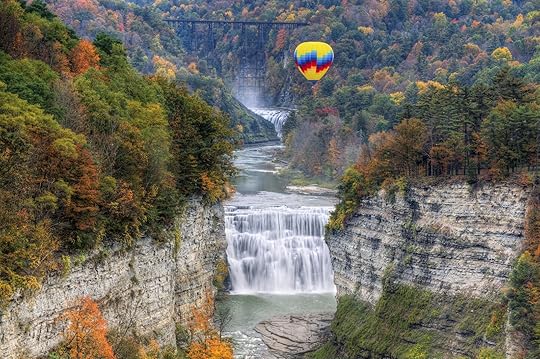
New York might be synonymous with the city that doesn’t sleep, but the Empire State is more than crowded subway cars and steely skyscrapers. While NYC covers 193,000 acres, the state’s park system covers roughly 350,000 acres – meaning New York’s landscape is actually more green-space sanctuary than concrete jungle.
North America’s most powerful falls? You’ll find them in New York. A miniature Grand Canyon? You’ll find that within NY’s borders, too. It’s no wonder over 78 million people visit New York state parks annually, since the hiking trails, historical sites, geological wonders, and peaceful campgrounds offered in the New York state parks system offer opportunities to beat the urban bustle and connect with the sublime and natural.
Whether it’s summer swimming in blue lakes, admiring fall’s painter-palette forests, skiing across snow-packed fields, or watching waterfalls roar in spring, there’s no wrong time to visit New York’s pastoral pleasure zones. But with 180 state parks, choosing the right destination can be tricky.
Here are the 10 most magnificent state parks in New York, stretching from Long Island’s Atlantic shores to Canada’s gorge-carved border.
Niagara Falls State ParkLetchworth State ParkMinnewaska State ParkTaughannock Falls State ParkHudson Highlands State ParkSaratoga Spa State ParkHarriman State ParkRobert Moses State ParkAllegany State ParkMarsha P. Johnson State ParkMap of the best New York State parksThe best state parks in New York are spread between the state, ranging from a park in the heart of Brooklyn to a park that straddles the US-Canadian border. So no matter where someone is in the state, there’s probably an amazing state park not too far away.
Niagara Falls State ParkBest for:Wild waterfalls
Photo: wonderlustpicstravel/Shutterstock
It’s hard to be humble when listing this natural wonder’s attributes. Niagara Falls is the country’s oldest state park (established in 1885) and the inspiration for both state and national park systems in the US. Famed landscape architects Federick Law Olmsted and Calvert Vaux (the team behind NYC’s Central Park) designed the rambling walkways and overlooks spanning the 400-acre oasis, and it has nine million annual visitors, making it the state’s most popular green space.
But there’s nothing more impressive than the park’s roaring centerpiece. Over 3,000 tons of water rush over Niagara Falls every second, making it the strongest waterfall in North America. Many say the cascade’s Canadian side offers better views, but the adventures on the New York side make a stop in this park worthwhile.
To get a closer view, travelers should hop on the electric Maid of the Mist ferry (open April through November) for a wet-and-wild tour on the Niagara River. A piece of advice: be sure to wear the complimentary rain poncho; the waterfall’s spray is relentless. Visitors dying to get drenched should scramble outside the Cave of the Winds Pavilion’s Hurricane Deck, just an arms-length from the falls. The park’s Observation Tower also offers a less-soggy panorama of the Niagara Gorge.
Should the New York side’s amenities still fail to impress, Canada’s photo-ready views are only a short jaunt away across the Rainbow Bridge — just remember your passport.
Letchworth State ParkBest for: A diverse group of travelers
Photo: Jim Vallee/Shutterstock
It’s easy to see why Letchworth State Park is called “The Grand Canyon of the East.” The New York state park’s sheer limestone, sandstone, and shale cliffs shoot 600 feet into the sky from the bottom of the 17-mile-long gorge carved by the relentless Genesee River.
Letchworth is an easy day trip from Rochester or Buffalo (each an hour’s drive away), but it’s worth spending two days in the thrilling corner of Western New York. The indigenous Seneca, who tended the land long before European colonizers arrived, believed the sun paused over the gorge’s falls daily to admire its beauty — a cue that visitors should consider spending serious time here.
The area’s hot air ballooning and white-water rafting will appeal to adrenaline junkies, while the Autism Nature Trail caters to folks with developmental and physical disabilities on a mile-long, sensory-friendly excursion. Hikers can choose from over 60 trails, but the most popular is the 7.1-mile Gorge Trail — a one-way trip showing off the park’s top sites, including three enthralling cascades. The 60-foot-high Upper Falls, crowned with a 200-foot-high railway bridge, is the most idyllic, followed by the Middle Falls and the Lower Falls, both of which require a 100-step descent. In winter, snowshoes replace hiking boots as visitors take advantage of the icy season.
Book a room at the Glen Iris Inn, the former home of the park’s founder, William Pryor Letchworth, for a charming weekend stay. The cozy hotel opened in 1914 and overlooks the Middle Falls.
Minnewaska State ParkBest for: Year-round visits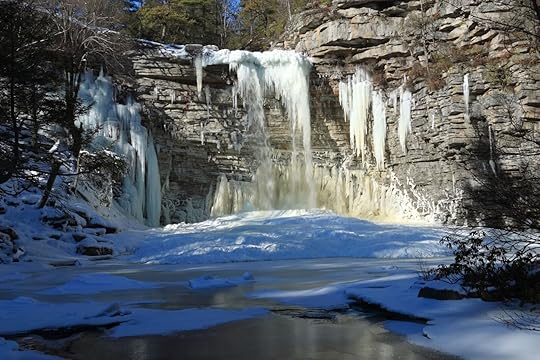
Photo: Colin D. Young/Shutterstock
The Shawangunk Mountains, a 71-mile-long pearly ridge of craggy quartz, cuts into the sky near New Paltz, a quirky college town 90 miles north of NYC. It’s where you’ll find one of the best New York state parks for year-round adventures: Minnewaska State Park Preserve, a dramatic wilderness covering 24,000 acres with rain-fed sky lakes, fantastic cascades, serpentine paths through pitch pine forests, and rugged cliffs beloved by rock climbers.
In summer, Lake Minnewaska’s pine-fringed shoreline becomes a family-friendly swim spot, while Lake Awosting serves as a refreshing (and popular) spot for a quick jump into the lake from rock slabs at the midpoint of the 3.1-mile Upper Awosting Trail.
When autumn arrives, drive to Sam’s Point, roughly 30 minutes from Lake Minnewaska, for top-notch leaf-peeping. A one-mile stroll along a well-paved carriage road leads to views of the Wallkill Valley’s kaleidoscopic woodlands.
Winter snow makes the park’s well-groomed trails ideal for cross-country skiing and snowshoeing. A particularly beautiful route for first-timers is the easy Awosting Falls Connection Trail, which leads to views of cliff-clinging icicles along Awosting Falls’ 60-foot plunge.
By late spring, Sam’s Point is again the place to be. Water gushes from the 187-foot drop at Verkeerder Kill Falls, and the 3.3-mile Ice Cave Trail leads to cool rock crevices that retain snow well into the hottest days of summer.
Taughannock Falls State ParkBest for: Gorgeous gorges
Photo: Paul Massie Photography/Shutterstock
“Ithaca is gorges,” the slogan for upstate New York’s hippie Finger Lakes college haven, is more than clever wordplay — it’s a fact. Glacier-carved gorges surround Ithaca, and a visit to one of the nearby state parks promises the sight of waterfalls cutting through stone cliffs.
Watkins Glen, Robert H. Treman, and Buttermilk Falls state parks teem with hiking trails and water features. But for the most impressive cascade, head to Taughannock Falls State Park. Its eponymous waterfall plunges 215 feet, making it 33 feet higher than Niagara and the tallest free-falling cascade east of the Mississippi.
A viewing platform near the parking lot leads to exceptional views of the falls, but hikers willing to put in a little leg work can reap serious rewards. For a misty view from the base of the falls, follow the 1.8-mile Gorge Trail, which passes the 20-foot-tall Lower Falls before arriving at the park’s pièce de résistance.
For something more strenuous, try the three-mile round-trip hike to the North and South Rims, offering views of the famous waterfall and sparkling Cayuga Lake (the longest of the eleven Finger Lakes) along the way. In summer, the park’s Taughannock Beach is a popular spot to refresh with a jump in the water post-hike.
Hudson Highlands State ParkBest for: Hiking near NYC
Photo: James Andrews1/Shutterstock
Covering 8,000 acres of the Hudson River’s western banks between the charming towns of Peekskill and Beacon, the expansive Hudson Highlands state park is a hiker’s dream come true. It’s one of the best New York state parks to explore on foot, with more than 70 miles of paths through forests thick with oak, maple, beech, and elm trees, bridging rocky shores and bald-faced mountain peaks. The scope of wilderness is mind-boggling, considering Manhattan is only a 1.5-hour car or train trip away. Try to go midweek, or be willing to deal with crowds on weekends as NYC’s nature-starved urbanites flock to the park’s most challenging trails.
Experienced hikers should try their hand at Breakneck Ridge, a breathtaking 3.2-mile scramble with near-vertical climbs and vistas that make it worth the exertion. The trailhead, reachable by train, is a favorite for car-free New Yorkers.
Hikers with more time to spare can take the 5.4-mile loop trail to Bull Hill to see the most diverse landscapes in the park. The trail starts near the Hudson River and climbs to a lookout facing Storm King State Park on the east side of the river. As the trail descends, scrubby trees give way to giant oaks, leading to the Cornish Estate — an abandoned property from 1910, overgrown with shrubs and dusted with leaves.
For an afternoon hike with even better panoramas, take the 3.8-mile climb to Mount Beacon Fire Tower. After scaling a 200-step staircase, hikers will reach the ruins of a 20th-century with views of Beacon (an artsy riverside enclave) just below. But the best views are for hikers who keep climbing to the mountain’s rocky peak, from which there are 360-degree views of the Hudson Highlands, the Shawangunks, and the Catskill Mountains.
Saratoga Spa State ParkBest for: Drinking water straight from the tap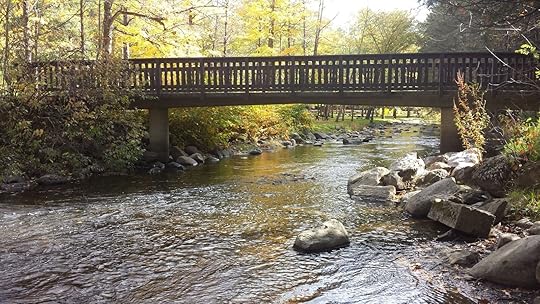
Photo: Angela Guzman/Shutterstock
Salty and sulfuric with an aftertaste of iron describes the taste of the water from mineral springs gurgling throughout Saratoga Spa State Park, which has attracted taste testers for centuries. Indigenous Iroquois and Mohawk communities considered the springs a source of healing; an idea later stolen by colonizers in the 1700s.
By the mid-1800s, the area boomed with tourists hoping to cure all sorts of maladies, and in the early 19th century, New York State stepped in to conserve the springs from overuse. Today, travelers come to sip mineral water like glasses of fine wine. It makes for a lovely preamble before doing what the relaxing New York state park’s name suggests: unwinding at the spa.
The best way to see the famous springs is via the 2.9-mile Geyser Creek Trail. Be sure to have a water bottle handy for the Saratoga Geyser, one of the only active geysers east of the Mississippi. But be careful how much you drink: a full bottle from the Orenda Spring might leave you smelling like eggs, and too much of the Hayes Well Spring (believed to relieve constipation) could induce a trip to the bathroom.
After becoming a Saratoga Springs sommelier, check out the park’s multiple museums, outdoor performing arts center, golf course, and the handsome Gideon Putnam Hotel (open since 1935). But of all the jewels crammed into this 2,300-acre expanse, nothing beats the Roosevelt Baths and Spa. It’s a Georgian Revival-style bathhouse where current-day guests can soak in the beloved waters, just as visitors have done for hundreds of years.
Harriman State ParkBest for: Roadstrippers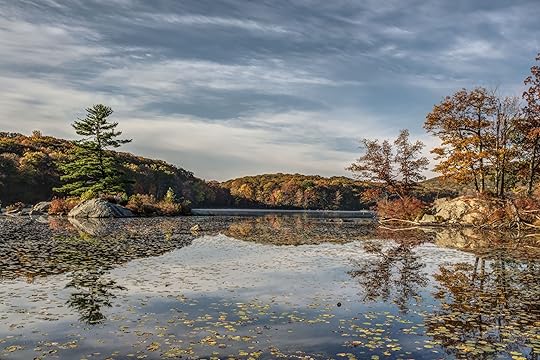
Photo: John A. Anderson/Shutterstock
The second-largest of the New York state parks comes with 47,527 acres of first-rate scenery, including more than 30 lakes and ponds, roughly 58 named mountain peaks, and 200 miles of hiking trails connecting two other state parks (Sterling Forest and Bear Mountain).
Unlike many spots on this list, some of Harriman’s most stunning landscapes are reachable by car, making it one of the best state parks in New York for road tripping and leisurely drives. Cruise down Seven Lakes Drive to pass (shocking) seven lakes on a winding two-lane road stretching for over 15 miles. Expect to spot bikers huffing and puffing on the road’s shoulder as the scenic route is a cyclist’s dream.
Near large parking lots are beaches at Lake Tiorati and Lake Welch, which attract swimmers in summer. And a stretch of the Appalachian Trail brings grizzled thru-hikers into the park for 18 miles, offering the rare sight of Manhattan skyline views along a distance trail.
For a satisfying day hike, try the Reeves Brook Loop Trail — a 3.8-mile slog up Chipmunk Mountain featuring a 50-foot rock scramble and vistas overlooking bucolic plateaus.
Should the surroundings inspire more than a few-hour visit, consider pitching a tent. Two public camping areas accommodate overnight stays, and there are no-gear-required rentable tent sites around Silver Mine Lake.
Robert Moses State ParkBest for: Beach bums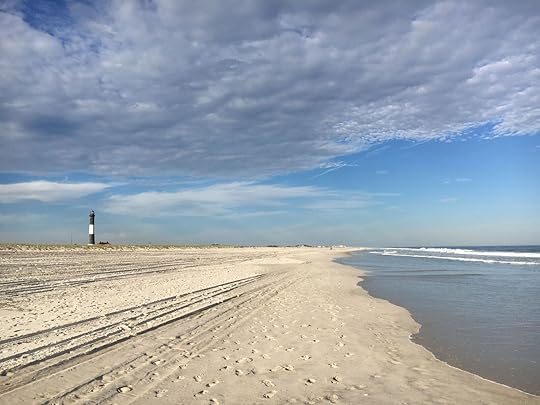
Photo: Joe Trentacosti/Shutterstock
There’s no shortage of beautiful beaches on Long Island’s Atlantic coast. Ditch Plains Beach in Montauk serves up the state’s best surfing conditions, Jones Beach attracts summer swarms with seasonal entertainment, and the Fire Island National Seashore captivates with 26 miles of soft sand and windswept dunes. But as for the shore at Robert Moses State Park, well, it delivers a bit of everything.
The park’s five-mile beach near the Fire Island National Seashore’s western edge is split between several parking fields. Field 2 draws putting pros with its 18-hole golf course, and nearby Democrat Point becomes a surfer magnet during autumn’s sea swells. Fields 3 and 4 offer tranquility: both are radio-free, so the only soundtrack you’ll hear is the ocean’s crashing waves.
But most sun worshippers end up at Field 5, thanks to a nature trail leading to the Fire Island Lighthouse, built in 1858. Visitors willing to climb the 182 steps to the tower’s observation deck are rewarded with views of Long Island stretching eastward and, on clear days, NYC gleaming to the west.
To beat the summer crowds, make the 30-minute stroll from Field 5 to Kismet Beach. Though it’s technically outside the park boundary, the stretch of sugary sand is a sweet strip of serenity only 90 minutes from Manhattan.
Allegany State ParkBest for: Winter sports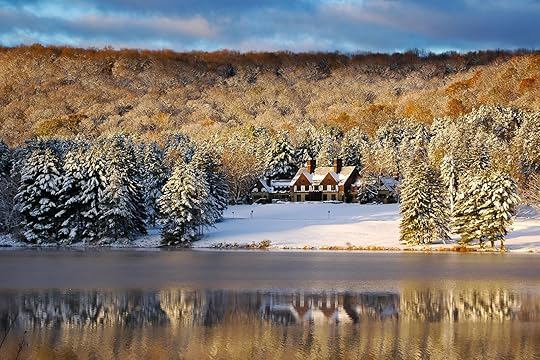
Photo: Jeffrey M. Frank/Shutterstock
The largest of the New York state parks covers a whopping 65,000 acres of western New York with open meadows, old-growth forests, three lakes, and 18 hiking trails — all of which stand out from other state parks once winter arrives.
The park is in a snow belt created by nearby Lake Erie, so sheets of white cover the park from late fall to early spring. The park service maintains well-groomed snowmobile trails snaking across the landscape, hiking paths become hot spots for cross-country skiing, and dozens of the park’s cabins are winterized for cold-weather glamping (which visitors can book online). The park’s blanket of white snow creates a contrast that makes it easy to spot wildlife; white-tailed deer frequently hop between trees, and the red coats of foxes spark like fire across the snowy fields.
That said, it’s equally lovely in summer. June, July, and August are best for swimming in the park’s lakes and exploring the woods. For a perfect Allegany day, take a 4.4-mile trek to see the massive boulders of the Bear Caves, then drive 20 minutes to the Tudor-style Red House Administration Building to peruse a museum dedicated to native flora and fauna. End the day at Red House Lake, where bike and boat rentals make it possible to circle the artificial pool’s 2.7-mile shoreline.
Marsha P. Johnson State ParkBest for: Urban explorers and foodies
Photo: MisterStock</Shutterstock
The seven-acre slab on Brooklyn’s East River might not seem like an ideal refuge for Mother Nature. After all, it trades views of rolling mountains for views of Manhattan’s skyline, and wild animals for well-heeled hipsters. And rather than native plants poking up from the earth, it’s railroad ties dotting the trails (relics of the area’s 19th-century industrial past). In fact, the park isn’t even the river’s most attractive green space — Brooklyn Bridge Park offers more riverside trails and amenities. But the scrappy Marsha P. Johnson State Park is well on its way to becoming one of the state’s best new parks.
In 2020, it became New York’s first state park named after an LGBTQ+ person: Marsha P. Johnson. She was a Black transgender activist who helped pioneer the modern fight for LGBTQ+ rights. Since renaming the park, the state has been busy making improvements, including a new native-species perennial garden, a floral mound dubbed “Marsha’s Hillside,” and interpretive panels documenting the life of the late legend. In 2023, construction will begin on a new park entrance, welcoming guests through a gateway made of fabricated flowers, akin to the bouquet Johnson once wore in her hair.
Fortunately, the small area already offers some of the best activities in the New York state parks system. Smorgasburg, a pop-up food fair where local vendors hock tasty treats, takes over the park every Saturday from spring through fall. And world-class shopping and dining are across the street, including Artists and Fleas Williamsburg (a local artisan and craft fair) and Jajaja Mexicana (a plant-based Mexican restaurant). It’s a safe park to visit at night, when locals gather at picnic tables to watch the sun set behind Midtown, watching as Manhattan’s highrises begin to twinkle like grounded stars.
Camping in New York state parks
Photo: noppawan leecharoenphong/Shutterstock
When it comes to sleeping under the stars, campers in New York are spoiled for choice. There are more than 8,500 campsites throughout the 180 state parks in New York, many of which have fire pits, picnic tables, restrooms, and RV-friendly amenities like electric, water, and sewer hook-ups.
Nature novices can dip their toe into outdoor living at one of 800 cabins in the state park system, furnished with beds or cots, stoves, and refrigerators. There are also 129 cottages, including sites in Allegany, Harriman, Letchworth, and Taughannock Falls state parks. They’re best for nature newbies, as the full kitchens, bathrooms, and beds supplied with linens make the coveted rentals one step away from a hotel.
Travelers can make reservations as early as nine months in advance or as late as the morning of their arrival, but it’s best to book the most covered campsites (which include most of the parks on this list) as soon as possible. Waking up with something like New York’s largest waterfall in your backyard is a sought-after luxury, particularly in summer. 
More like thisBeaches and IslandsThe Best Beaches for a Long Weekend Trip From New York City
7 ways to have winter fun in Quebec

In most places across northern North America, winter slows the world down. But not in Québec. Come wool-scarf weather, this Canadian province gets perfectly blanketed in fluffy white snow, there’s a celebratory spirit in the air, and new adventures take shape.
If you can handle bundling up, mugs of hot chocolate, and staying active, winter in Québec brings a world all its own to explore. We’re talking European-style cities, crashing waves and sea views, snow-covered ski towns, moose and elk, and stay-cozy dishes like lobster poutine. This year, say bonjour to winter in Québec with these seven ideas.
1. Live out a winter fairytale in a Québec city.
Photo: Tourisme Québec/Gaelle Leroyer
There are few big cities in the world that become more beautiful in winter, but Québec’s two hubs — Montréal and Québec City — are definitely on that list. Just imagine strolling under the twinkly lights of a 17th-century old town, pausing for a hot chocolate or cup of coffee. (Montréal’s Café Olimpico gives you such a vibe, as does Old Québec’s Café La Maison Smith on Rue des Jardins, located across from City Hall and around the corner from Notre-Dame de Québec.)
Just remember to do as the Québecers do and savor the season by having fun outdoors. Skate on top of Mount Royal in Montréal, toboggan down an ice slide built in 1884 in Québec City, or cross-country ski on trails in and around the cities. When you’re in need of a fuel-up, there’s nothing as soothing on a cold winter’s day as a steaming plate of fries, cheese curds, and gravy (aka poutine) — try Chez Ashton in Québec City or Chez Claudette in Montréal.
Know that whichever city marks the start of your Québec winter journey, you can expect a jovial atmosphere — people here just love this time of year. That means winter festivals, unique outdoor installations, and lots of smiling faces tinged red with the nipping cold.
2. Get to know Québec’s national parks.
Photo: Tourisme Québec/Francis Gagnon
Ask any Québecer what makes winter so special, and they’ll give you a simple answer: winter sports. With a network of around 50 national parks and wildlife reserves plus 180 major regional and municipal parks, no one need worry about cabin fever.
For instance, you can snowshoe along 14 miles of trails before searching the skies at ASTROLab in Mont-Mégantic National Park, the world’s first international dark sky reserve. Other notable national parks include Saguenay Fjord, which, as the name suggests, runs along a 65-mile-long fjord, and Aiguebelle, where you can climb frozen waterfalls. Camp de Base Abitibi-Témiscamingue instructors will happily show you the ice-climbing ropes (and ice axes and crampons).
3. Visit winter creatures — and maybe sleep with the wolves.
Photo: Tourisme Québec/Denis Poulin
At Québec’s Parc Oméga — approximately halfway between Montréal and Ottawa — live out your Snow White dreams by playing with lovable forest friends…safely through the window of your car.
There’s a 7.5-mile safari drive, where you can steer your vehicle past some 400 animals, including majestic moose and elk, winter foxes, and black bears. When the safari’s done, stay the night in one of the park’s luxury cabins or chalets. You might just see wolves playing in the snow beyond your floor-to-ceiling windows. The park also has yurts, tipis, treehouses, and more unique lodging options for an incredibly memorable stay.
4. Ski at the peak of eastern North America.
Photo: Tourisme Québec/Pierre Carbonneau
If you’re on the East Coast and love skiing and snowboarding, there’s nowhere that can spoil you for choice like Québec. The province has more than 75 resorts, including big names like Mont-Tremblant, Stoneham, and Le Massif de Charlevoix. (Le Massif enjoys superb views of the St. Lawrence River from its slopes).
It’s worth spending the weekend near whichever mountain you choose, as many Québec ski towns have a lot to offer in terms of quality hotels, classy après-ski dining, and stress-evaporating spas.
5. Ditch the wheels — take a winter road trip on blades.
Photo: Tourisme Québec/Mathieu Dupuis
Québec is the birthplace of the snowmobile — which, for the unacquainted, is like a Jet Ski on snow — and they’re insanely fun to drive. Take one out for a few hours on the province’s 20,000+ miles of snowmobile trails. Or, to get really off the grid, opt for a multi-day saddlebag adventure with a guide. This helpful resource has trail maps, packages, and even an app to track your journey.
6. Go ice fishing like Anthony Bourdain.
Photo: Tourisme Québec/Tourisme Lanaudiere/J. Vigneaux
Ice fishing is almost exactly what it sounds like — you station yourself in a hut on the ice and stick your rod through a hole into the water. Except in Québec, where the huts come rentable, decorated, fully equipped, and sometimes heated. It’s surprisingly fun, especially when accompanied by seared duck, truffles, and excellent local wine as Anthony Bourdain enjoyed on the Québec episode of Anthony Bourdain: Parts Unknown.
One particular ice fishing hotspot is Sainte-Anne-de-la-Pérade, an hour from Québec City, which puts up some 500 ice fishing huts during the season (generally from January to mid-March). Otherwise, you can test your auger on almost any of Québec’s thousands of frozen lakes — or even on the St. Lawrence River, widely considered one of the best in the world for catching pike, walleye, yellow perch, and bass come winter. Check out this page for a list of those rentable, fully equipped ice huts across the province.
7. Explore the “edge of the Earth.”
Photo: Tourisme Québec/Steve Deschenes
The Gaspésie region — the thick peninsula that juts out over the top of New Brunswick — has all of Québec’s cultural charm combined with colorful riverside homes similar to those you’d find in Halifax or Newfoundland. It’s also home to some very tasty seafood (lobster poutine anyone!?). But Gaspésie also has an ace in the hole: It claims one of Canada’s prettiest national parks, Forillon.
In winter, the park — which features stellar sea views and cliffs that look like human faces — is refreshingly uncrowded, perfect for undisturbed exploration of its many cross-country ski, snowshoe, and fat-bike trails. One recommended easy-to-moderate trek is the 5.7-mile La Vallée Trail; at the halfway point, warm up next to the woodstove in the Répit-Nord shelter.
While in Gaspésie, journey to the peninsula’s eastern tip for a glimpse of Percé Rock, a nearly 300-foot-tall limestone block rising from the waves just offshore. Cut into the side of the massive formation is one of the largest sea arches in the world. Percé Rock provides the kind of view that has a distinct “edge of the Earth” feel to it — a perfect capstone for your Québec winter adventure. 
October 2, 2022
This Coffee Will Be Shot Into Space on Tuesday. But You Can Try It Here on Earth, Too.

When co-founder Sam Higby choose “First Ascent” as the name of his coffee company in 2014, he may have meant ascending peaks, not ascending into space. But on Tuesday, the Colorado coffee brand will have its award-winning instant coffee sent into space as the coffee of choice for the upcoming SpaceX Crew-5 mission to the International Space Station, launching from the Kennedy Space Center on Oct 4 (or 5, if the weather is bad on Oct 4).
“In August 2021, I received an email asking if we could do large batches of coffee,” says Higby. “It seemed like a fairly generic question and sales lead until I noticed the domain name — nasa.gov —which definitely piqued my curiosity.”

First Ascent is a Colorado-based instant coffee brand popular with backpackers, campers, and mountaineers. Photo: First Ascent Coffee / Phillips Photo
It turns out that generic sales lead was from NASA’s Space Food Systems Laboratory, which sources and adapts food for life in space for astronauts. The Crested Butte, Colorado-based First Ascent Coffee Roasters team sent samples off to the lab where, according to Higby “[astronauts] taste-test food and beverage options and then they set their own menu for the time they are on board.” The astronaut Higby spoke with said they had tasted half a dozen options, all of which were unappealing. But a fellow astronaut knew of First Ascent coffee from a backpacking trip and recommended it to the rest of the crew.
It passed muster, apparently, as NASA ordered 256 eight-ounce servings of the brand’s Dawn Patrol instant coffee to ship off with crew of the SpaceX Dragon Endurance craft. Two NASA astronauts, one astronaut from the Japan Aerospace Exploration Agency, and one Russian cosmonaut will spend six months aboard the ISS, which certainly supports First Ascent’s slogan of providing “coffee to fuel people off the grid.”
For most coffee buyers (i.e. buyers staying on Earth), the entire coffee production process is done in-house at First Ascent’s Crested Butte headquarters, from roasting to brewing, freeze-drying, and packaging. But for NASA’s special order, the coffee will have to be packaged just a bit differently. Because of the lack of gravity in space, there’s no option to pour hot water over the coffee, or even pour water into an empty cup.

This 2015 photo shows how astronauts drink coffee from packets, using the hot water machine (on right) to force water into the sipping pouch. Photo: NASA/Scott Kelly
Instead, First Ascent provides the grounds, and NASA’s Food System Lab will put the grounds into a space-friendly package: a foil pouch with a valve on one side. Astronauts attach the valve to a hot water dispenser to mix the grounds, then insert a straw into the valve, and boom: First Ascent’s dark-roast coffee, roughly 260 miles off-the-grid.
First Ascent instant coffee and ground beans and available in stores only in Colorado, but the company offers free shipping on all online purchases of instant coffee to anywhere in the US. More like thisCampingThe Best Ways To Make Coffee While Camping, According To Experts
More like thisCampingThe Best Ways To Make Coffee While Camping, According To Experts
September 30, 2022
Northern Lights Expected To Make an Appearance This Weekend in the US

When you think of the northern lights, you probably think you have to take a trip far north, somewhere like Alaska, Canada, or northern Europe, to get a glimpse of this phenomenon. It turns out that every once in a while, with a bit of luck, you can catch a peek in the northern region of the United States. This weekend, from September 30 to October 3, scientists are optimistic about the opportunity for this natural light show to be visible in the US.
The odds of seeing aurora borealis (a fancy way of saying northern lights) are ranked on the Kp Index from zero to nine by the University of Alaska Fairbanks Geophysical Institute, with zero being no chance of visibility and nine being the best chance of visibility. The higher the number gets, the larger pool of the hemisphere will be able to see the lights. Unfortunately, like most natural events, there’s no guarantee you’ll be able to see them. Today, September 30, the Kp Index sits at a five, peaking at a six for October 1, and then back down to five from October 2 through 4. Some states have already caught glimpses of the lights, including Massachusetts.
The #northernlights are very visible in Massachusetts right now now! #mawx pic.twitter.com/doFAamQAbp
— Colton Flint (@Tornadof123) September 27, 2022
Below are the states where you have the highest probability of seeing the northern lights.
States where you can see the Northern Lights on March 31 and April 1 and 2MaineMichiganMinnesotaMontanaNorth DakotaSouth DakotaWashingtonWisconsinStates where you might see the Northern Lights on March 31 and April 1 and 2IdahoIllinoisIndianaIowaNebraskaOhioOregonPennsylvaniaWyomingThe northern lights’ colors are created by protons and electrons leaving the sun and hitting the Earth’s magnetic field. This causes gasses naturally found in the atmosphere to change — oxygen makes the green and red lights while nitrogen makes the blue and purple lights.
If you aren’t lucky enough to be in one of the states for the light show, Explore.org is running a live stream from Churchhill, Canada, to get you as close as possible to the real thing.
 More like thisOutdoorThe Best Places To See the Northern Lights in the Continental United States
More like thisOutdoorThe Best Places To See the Northern Lights in the Continental United States
Matador Network's Blog
- Matador Network's profile
- 6 followers



